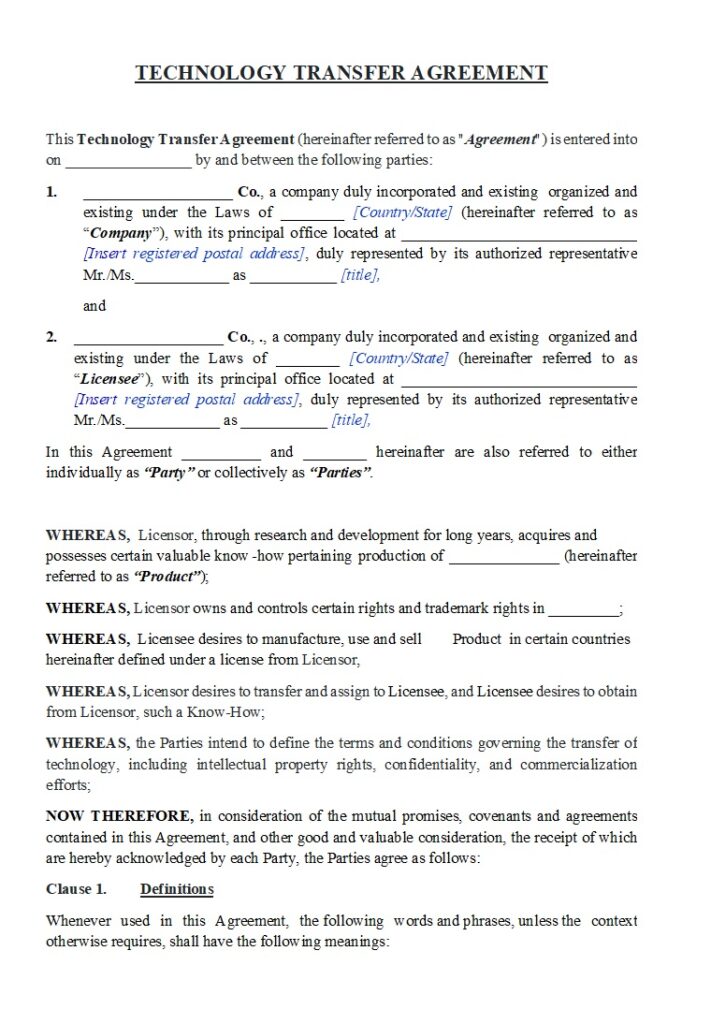Estimated reading time: 3 minutes
A Technology Transfer Agreement involves the transfer of proprietary technology or know-how, or research results from one party (the licensor) to another (the licensee). Industries such as biotechnology, pharmaceuticals, manufacturing, renewable energy, and information technology use this document widely because they rely on innovation and intellectual property as core commercial assets.

Definition and Purpose
The purpose of a Technology Transfer Agreement is to provide the licensee with authorized access to use, adapt, or commercialize specific technology owned by the licensor. This transfer can include patents, software, designs, manufacturing methods, technical processes, or confidential know-how. By doing so, it allows the licensee to enhance productivity, improve product quality, or enter new markets while maintaining the licensor’s ownership and control over the intellectual property.
Structure and Major Provisions
A well-drafted Technology Transfer Agreement should contain detailed clauses that clearly define the scope of the transferred technology and the permitted uses. Typical sections include:
- Grant of Rights: Specifies the type of license (exclusive, non-exclusive, or sole) and the territorial and temporal limitations of its use.
- Confidentiality Obligations: Protects proprietary data and trade secrets disclosed during the transfer.
- Intellectual Property Ownership: Confirms that the licensor retains ownership and governs how improvements or derivative works are handled.
- Royalties and Payment Terms: Outlines the financial arrangements, such as upfront fees, milestone payments, or royalty structures.
- Compliance and Quality Control: Ensures that the technology is applied according to agreed standards and relevant laws.
- Warranties and Liabilities: Defines the responsibilities of each party in case of defects, misuse, or third-party infringement claims.
- Termination and Dispute Resolution: Provides mechanisms for ending the agreement and resolving disputes through arbitration, mediation, or litigation.
Technology Transfer Agreements drive innovation and strengthen collaboration among universities, research institutes, and corporations. They spread technology across borders, stimulate economic growth, and build lasting industrial partnerships. Each agreement must follow national and international rules on export control, competition, and intellectual property.
Parties should negotiate clear terms. It protects the licensor’s intellectual property and still allows the licensee to use the technology productively. Clear language in the contract ensures both sides understand their rights and limits. It also prevents disputes, misuse, and unauthorized copying.
Practical Application
Technology transfer happens through licensing, joint ventures, franchising, or research partnerships. For example, a pharmaceutical company can license its patented drug formula to a regional manufacturer to produce it locally under set quality standards. Universities also use these agreements to bring their research-based inventions into commercial use.
These contracts strengthen innovation networks and support the responsible use of new technology. They turn research into real products and connect scientific progress with market demand.
Related templates:
References:
- World Intellectual Property Organization (WIPO) – Technology Transfer and IP
- European Commission – Technology Transfer Guidelines
- World Bank – Knowledge and Technology Transfer
- Investopedia – Licensing Agreement Definition
has been added to your cart!
have been added to your cart!



